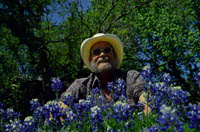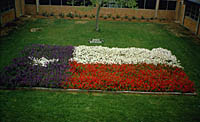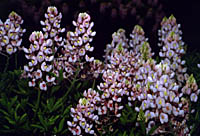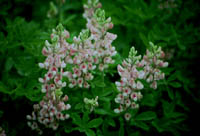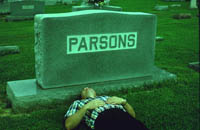
1. Seeding colorful Bluebonnets for glorious spring patriotic color.
See also information from Wildflowers in bloom.
BY JERRY M. PARSONS, Ph.D.
Specialist and Professor of Horticulture
Texas Cooperative Extension
Texas A&M University System
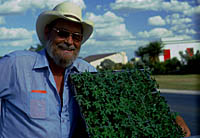 All of the other developments such as bluebonnet transplants; rapidly germinating, chemically scarified seed; commercial seed production; early-blooming plant types; etc. were all necessary ingredients needed to find and proliferate the colors needed-- blue, white and red--to plant the initial floral goal -- a Texas' state flag.
All of the other developments such as bluebonnet transplants; rapidly germinating, chemically scarified seed; commercial seed production; early-blooming plant types; etc. were all necessary ingredients needed to find and proliferate the colors needed-- blue, white and red--to plant the initial floral goal -- a Texas' state flag. The blue bluebonnet was, of course, already available. The only thing needed to be done with the blue was to enhance seed germination and formulate a commercial production technique which would insure a dependable seed supply.
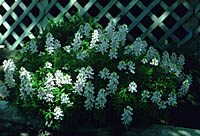 The white strain of bluebonnet was somewhat common yet still unknown to the majority of Texans. Photographers always treasure the opportunity to find an albino nestled among the blues to enhance their artistic attempts. Consequently many people knew where white populations existed. When attempting to locate and gather seed of the white bluebonnet population, a very wise criterion was used. People were told only to collect seed from whites in large groups so that natural selection had already bred some of the blue out of the white. The genetics of the whites were not clearly understood and we did not know exactly how many white blooming plants would be produced when planting seed collected from
white bluebonnets. Many skeptics indicated that it would take years to successfully complete the purification of a white strain. The first season that white seed were
collected and planted, 75 percent of the plants produced
The white strain of bluebonnet was somewhat common yet still unknown to the majority of Texans. Photographers always treasure the opportunity to find an albino nestled among the blues to enhance their artistic attempts. Consequently many people knew where white populations existed. When attempting to locate and gather seed of the white bluebonnet population, a very wise criterion was used. People were told only to collect seed from whites in large groups so that natural selection had already bred some of the blue out of the white. The genetics of the whites were not clearly understood and we did not know exactly how many white blooming plants would be produced when planting seed collected from
white bluebonnets. Many skeptics indicated that it would take years to successfully complete the purification of a white strain. The first season that white seed were
collected and planted, 75 percent of the plants produced 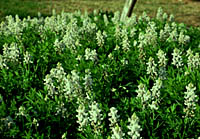 bloomed white the following year. That which some had said to be "impossible" had been accomplished in only two years. However, gardeners did not like the white color so that strain has been lost due to lack of interest and sales.
bloomed white the following year. That which some had said to be "impossible" had been accomplished in only two years. However, gardeners did not like the white color so that strain has been lost due to lack of interest and sales.
The common blue bluebonnet needed only some cultural problems solved to ready it for marketing and production. The white strain offered a significant challenge but nothing
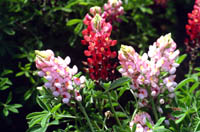 insurmountable. But the development of a pink-colored bluebonnet was thought to be a practically impossible task.Even Carroll Abbott considered locating, purification and proliferation of the pink, and eventually red, bluebonnet a bit far-fetched. This great plantsman had roamed the fields of Texas for years and had only seen three pink-blooming bluebonnet plants. Some of his native plant friends had never seen even one! But Abbott underestimated the thousands of searching eyes of wildflower enthusiasts that scoured every nook and crevice looking for the rarest of the rare and the effective production agriculture group which can proliferate many from a very few.
insurmountable. But the development of a pink-colored bluebonnet was thought to be a practically impossible task.Even Carroll Abbott considered locating, purification and proliferation of the pink, and eventually red, bluebonnet a bit far-fetched. This great plantsman had roamed the fields of Texas for years and had only seen three pink-blooming bluebonnet plants. Some of his native plant friends had never seen even one! But Abbott underestimated the thousands of searching eyes of wildflower enthusiasts that scoured every nook and crevice looking for the rarest of the rare and the effective production agriculture group which can proliferate many from a very few.
In searching for the pink color variant, the same criterion used to successfully locate and purify the white strain was used. People were told only to collect seed from pinks in large groups so that natural selection would have already bred some of the blue out of the pinks. However, the pinks indeed were so rare that only four locations throughout the entire state were reported. Oddly enough, the "mother-load" of pinks was found within the city limits of San Antonio. Shortly after some seed were gathered, the road maintenance crews graded the area and destroyed the entire naturally-occurring population. We have saved one of Nature's rarest gifts -- the pink bluebonnet. Once a gene source was located we were on the way to adding pink and shades thereof to the bluebonnet color spectrum.
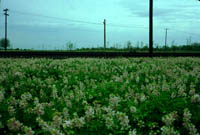 |
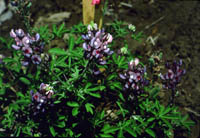 |
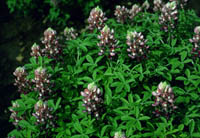 |
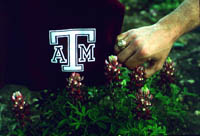 |
The spectacular and significant thing about the occurrence of these color types is that this is THE FIRST TIME IN THE HISTORY OF THE WORLD that these color variants have been seen and existed. Because there has never been quantities of pink bluebonnets, red or maroon colors would not have been able to be derived. For horticulturists and lovers of the Texas state flower, this is a significant historical happening -- we have seen what no person has seen before!
Once a color has been selected, isolated and seed proliferated, the REAL problem is maintenance of the seed supply. Some of the original farmers who grew the colored bluebonnets are no longer interested because of lack of sufficient and reliable profit. If the supplier quits, the seed of the color variants expires within 3-5 years. This has been the case with the maroon and red; no one wanted to increase the seed. An encouraging thing happened this year. John Thomas of Wildseed, Inc. (originally in Eagle Lake, Texas and now in Fredericksburg as well) has consented to grow the maroon, red and Abbott Pink bluebonnets.
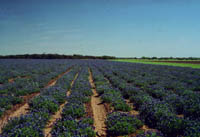 | 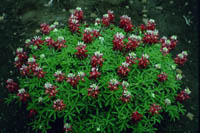 |
If we have several good growing seasons, all the seed and transplants Texans could want will be available for sale in the fall of 1998. Wildseed will package and distribute the seed nationwide - worldwide. John Thomas and his Wildseed Company has been a big supporter of Texas A&M University System activities and specially the work being done on wildflowers. The entire Wildseed catalog can be found on the horticulture website at:
http://aggie-horticulture.tamu.edu/cemap/lupines/maroon.jpeg and will probably be named 'Grant's Maroon' in honor of D. Greg Grant who was the first to recognize the potential of the Lupinus harvardii as a cutflower.
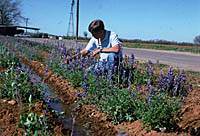
|
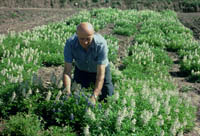 |
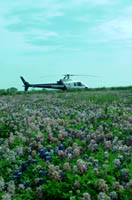
|
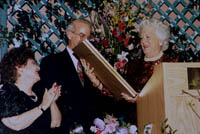 |
Maybe now the 17-year-old project can come to a close and I can finally
More can be learned about bluebonnets at the following PLANTanswers sites:
-
Texas Bluebonnets -- Texas Pride
- The "Real" Story of the Maroon Bluebonnet
- How Long Does It Take to Grow a Texas Flag?
- History of the Colored Bluebonnets (feature video based on the TV presentation "Domestication of the Texas State Flower"; available in RealPlayer and Quicktime formats)
- Maroon Bluebonnet Comes to University of Texas – Austin Campus in 2014
- Legend and Lore of the Texas Bluebonnet – Texas Highways Magazine [April 2017]
- Video of the Bluebonnet Texas Flag
See More Beautiful Bluebonnet Images
First of all, the state flower is the bluebonnet, written as one word. A color variant of that flower would be properly described with the name of that color plus the name of the flower of which it is a color--consequently, white bluebonnet, pink bluebonnet, maroon bluebonnet is correct. Secondly, the colors of the state flower which have existed for as long as bluebonnets have bloomed HAVE NOT been changed. Additional colors other than the more common blue, which already existed in Nature and have for hundreds of years, were isolated and purified. No plant breeding or genetic manipulation of bluebonnets has been done except by God. Any complaints or criticisms concerning bluebonnet color strains and their attractiveness should be directed to Him--not to me. The maroon color is naturally occurring from the pink strain; if a Texas Longhorn burnt-orange bluebonnet appears, it will be proliferated. All of these colors have been developed to enhance the Texas state flower. ALL of these colors are legally the state flower. Now for the first time in history, color patterns of the state flower can be planted and enjoyed. What other flower comes only in one color? Shouldn't the Texas state flower be the best that it can be?
| BLUEBONNET COLORS | When Noah from the Ark did go, | The Lord for a sign did send the rainbow. | But man will forget when the bow is dry. | What will remind him to look to the sky? | How will he remember that to God he is bidden, | That beyond the blue sky heaven is hidden? | So from the bow God took white, pink and red, | To remind us of Jesus, who for sin -- blood was shed. | Then upon the bonnet He painted the hues, | And covered them up with the rainbow blue. | Then he scattered the bonnet all over Texas, | And the whole world admired the flower God gave us. | But it remained for an Aggie, cleverest of the land | To show us the rainbow, hidden by God's hand. | by Mrs. Paul Steigerwald La Pryor, Texas |

